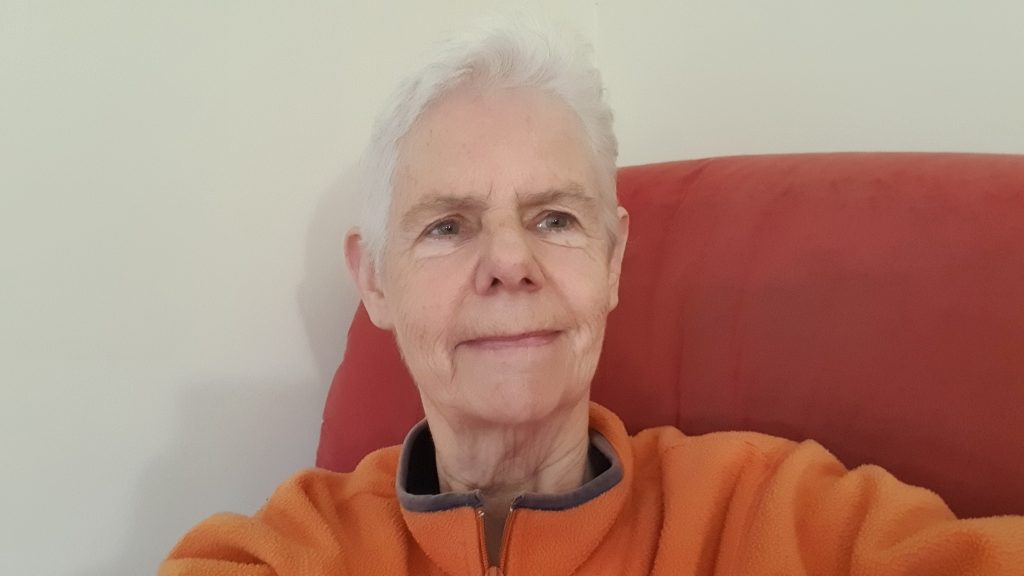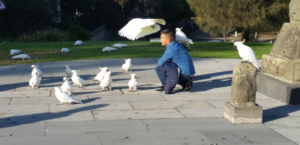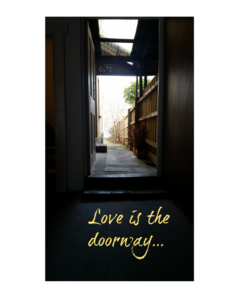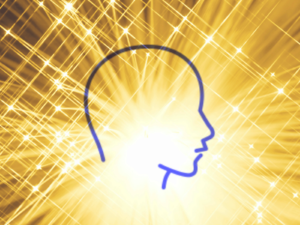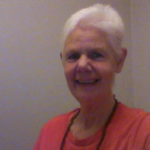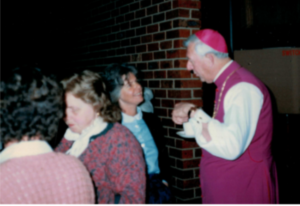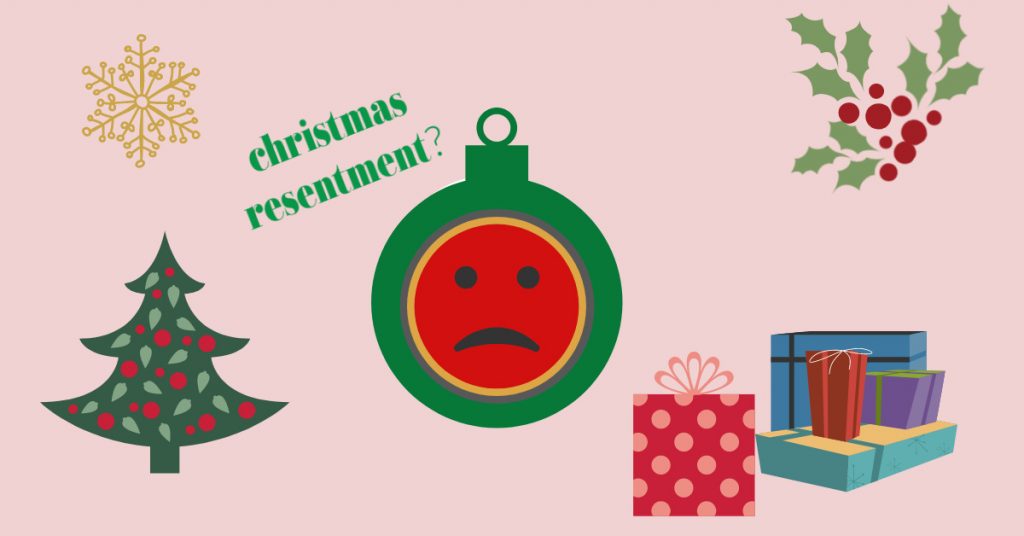Rane and Jo from Flowerarts wanted to interview me as 2nd President of Yoga Australia. They sent me some questions to answer for background notes. The interview meandered away from the notes from time to time. The podcast is conversational, but these notes are probably more considered. See which you like best! The podcast is here
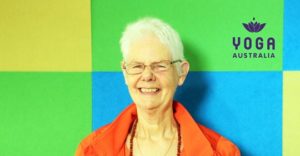 Rane and Jo
Rane and Jo
Swami Shantananda was kind enough to share some notes with us, which she references during our conversation. They are included here for completeness, and some great reading.
Can you tell us about your background?
I grew up Catholic. I was a very good Catholic girl. In year 12 we learnt a little bit of introductory Theology which interested me very much, whereas most of my classmates couldn’t have cared less about it.
Also in year 12, the magazine the Women’s Weekly (which was weekly then, and was a large sized publication at that time) included little pull-out booklet on this new thing call yoga.
I don’t recollect that there was anything about meditation or the history of yoga in it, but it was full of fantastic stretches and bends. I was a klutz on the athletics field but I just loved this new way of bending and stretching my body. Looking back I can see that it would have been better to have had a teacher for some of those asanas.
Next year when we had left school a friend found a yoga teacher and we began going to yoga classes. Still no meditation in any of the classes but I loved them, and as I shifted around from place to place later on, I found a yoga class pretty well wherever I was. There were the occasional gaps I suppose, but yoga has been a constant in my life since I was 16.
It was not for another 17 years that I learnt that yoga was traditionally and properly more about meditation and unitary consciousness than it was about exercises, even if those asanas and exercises maintain bodily health for rest of the work of yoga
Who were your key teachers?
I’m pretty sure my first teacher was a German lady who taught from a room in Balwyn in an L-shaped room, and she would sit at the corner of the two arms of the L. She was Iyengar-trained.
The only other teachers I have a clear memory of are a teacher at Warragul where I was living – she was the only yoga teacher that there was in Warragul, and so I went to her classes twice a week until I decided to take training myself from Joy Spencer.
The other yoga teacher that really made an impression on me was a woman called Pam – no idea of her surname but she taught at Mangala Studios at Carlton a long time ago. She was the only teacher that I had who had ever included a real meditation session as part of the class.
In all the years that I had been going to yoga until I did find out about meditation 17 years later, I left home, got married, had children and the ups and downs of domestic life. The yoga really didn’t teach me anything about how to live those experiences with anything other than I already came to yoga with. It taught me nothing about contentment, or being a good mother, or relating well …I certainly loved the yoga but the fact that meditation was missing from it I think was extraordinary.
I found out about meditation when I went to a “yoga foundation” which didn’t teach any asana! Or rather asana was the position that you sat for meditation.
So I began to explore. I meditated regularly and also began to study. I read all the yoga literature could lay my hands on, and in fact plunged into a great deal of Eastern philosophy and from there, quantum physics (as much as was published for the layperson with no maths!), and finally began to get a sense of the story of how yoga in the west came to be as minimal as it was, or perhaps still is. Just exercise classes with a bit of focused breathing?
How did you become involved in Yoga Australia?
Someone enrolled in my yoga class for only one term. Well, I thought she was pretty good at it, which surprised me because most of the people who came to suburban yoga classes were rather average. This one had great skill in Asana and finally she told me that she was a yoga teacher herself. And that some people were getting a yoga Association together and asked me if I would come along. I was nominated for the first committee and voted in. In my introduction to myself I think I quoted in Sanskrit the definitional line of the yoga sutras, haha, which probably surprised a few people back then, though many more people might be able to do that, now.
Were you playing a different role within Yoga Australia before becoming a president?
I was an ordinary committee member in that first year of the association, and we had a lot of work to do because we were establishing the parameters of what the association could be and the ideas that it was going to espouse. There was quite a bit of argee bargee between various members of the first committee. I was a noisy and sometimes rude voice for the spirituality and meditative aspects of traditional yoga. It was good training for me in articulating the point when others had no comprehension of what you might be getting at.
When did you become president of Yoga Australia? What was the process like? How long were you the president of Yoga Australia?
Well, I was the second president so I suppose that was 19 years ago that I became president and I was president for 2 years and so 17 years ago that I finished. The presidency had in the first place been intended to be one year and Jose Goossens had it for one year. That really wasn’t enough. In the early days of an association there is so much to do and it has no history except what you’re creating and so it’s not like an established Association that just requires maintaining. I think early on probably every president needed at least 2 years maybe 3. Anyway we changed it to 2 years in my time. I don’t know what the tenure is now.
Why did you take on the role?
I took on the role because a) I wanted to help the association to succeed. There was a terrible moment when we wondered if enough people would re-enrol after the first year to allow it to continue. And b) I wanted the Association to be fully representative of what yoga is, rather than be motivated by fear that people wouldn’t understand the historic and meditative aspects of Yoga.
What were the biggest challenges you found in the role?
The first big challenge was to get everybody on the same page about what yoga is. Maybe there never will be 100% agreement about that. But I certainly wanted to make sure that yoga was not simply presented as a series of exercises and that we had to allow for a sense of the traditional meditative and even spiritual purpose of yoga. And from the early days of Yoga coming into Australia – by the Women’s Weekly, for instance – that aspect was not commonly known, and so there had to be an explicit focus on it.
The other was manpower. There was so much to do and the committee members were all busy. What I would have given to have a staff and a budget! As we were all volunteers …well I don’t think it moved as fast as it could have, but we did a lot all the same.
What do you feel were your greatest successes?
Two things
One is that the association did embrace yoga as a bigger discipline than simply stretching and bending. That led directly to the second great achievement I think that the association made at that time, which was to see off an attempt by the fitness industry – supported by the government of the day – to appropriate yoga teacher training to the fitness industry.
Since yoga was beginning to come into gyms, the fitness bodies thought they ought to be able to train their own yoga teachers.
We would have had a great deal of trouble saying “No, you can’t do that” if yoga had been reduced by our own selves simply to exercise. It was wonderful that we had centuries of prior experience and teaching to support our own role in training and to deny it to the fitness industry.
Are you still connected to Yoga Australia?
No, after I had handed on the baton I decided to leave it to those who were then holding the baton. The secretary of my committee however, Sarasvati Sally Dawson, continued as secretary in the association for a number of years afterwards.
When did you become a swami? What prompted that decision? What was that process like?
A long time before I took sannyas my Guru had told me that I would become a Swami. That was not possible at the time that he said that it, either for me or from his own perspective. Then 10 years ago he said “Now it’s time” so I did!
In my lineage you don’t volunteer to be a swami or apply to be a swami, you wait to be invited by your teacher and when you’re invited it’s unmannerly to say no.
I accepted for the spiritual depth which that sort of commitment takes you to. The initiation happened in India – a day of Brahmin rituals and then the “secret” initiation before dawn the following morning.
I came home with a bald head, and very skinny, too, as I caught a tropical disease while I was there. Very cleansing!!
I see that you have done some of your meditation training with Ian Gawler and became a founding secretary of the Gawler foundation. We’ve both had a wonderful and deeply healing experience staying at the Gawler retreat following Rane’s cancer treatment. Would you like to share some of your own experiences with his philosophy and approach?
I hope Rane is feeling well!
I think I did my yoga teacher training with Joy Spencer and my meditation teacher training with Ian in the same year …
Ian is very charismatic. The way he helped people to heal was partly by his own example in having come back from the brink of life to the fullness of life, even though missing one leg (and now one lung as well, I believe)
Mostly what he did was to put his clients into a meditation state. He would take them through a guided visualisation – a method I eventually stopped using – so he would lead them to find a safe place or something like that, but then when he stopped talking, because of the quality of his voice and his charisma, they would slip into a deep still meditation.
I don’t know whether he attributed the mental process of visualising healing (eg the safe space), or whether it was the stillness, that he thought was the most healing aspect of what he did. In his own case, he learnt meditation from Dr Ainslie Meares, who accepted him as a patient on condition that he undertook to meditate in stillness 3 hours per day.
Something else that he used to do was to get people into a dyad, one person being completely still and non-responsive and the other person talking, and then swap sides – the point being that the ones speaking could just let their thoughts rise to the surface and be heard without being moderated by the person listening. Quite a process really. In the dyadic discussions there might be two questions, for instance at first, What is the downside of getting cancer? and then the other “What is the benefit of getting cancer?”
You’d think being asked to talk about “the benefit of getting cancer” would be distressing! In fact it made people do a double-take on what cancer is, and began to restructure their idea of their illness, and their life, probably.
He was a very young man when he published his first book You Can Conquer Cancer. He may have had some regrets about that as he matured, because as he did get older he had the recognition that people do die. He even would say jokingly with his cancer patients that “Even cancer patients can fall under a bus, haha…” So he revised his idea about living forever.
And sometime during his life he took a guru himself – the Tibetan lama Sogyal Rinpoche – and I suspect that as he matured his life became more directly spiritual, rather than incidentally spiritual.
I think that’s something that yoga / meditation really does for people. It’s that as you do mature as you get past enjoying just the stretching and bending, and you do get past thinking that you are going to live indefinitely, and you shift from futurist thinking into present moment awareness.
If you have taken the help of the deeper processes of the yoga tradition and shifted into deep stillness where you can observe the behaviours of your mind, rather than wanting to gain something for yourself, deep contentment comes with life just as it is and others just as they are.
You have a lot of academic philosophy in your background – what are the differences and similarities you’ve noticed between the academic approach and the yogic path of exploration?
As a teenager wandering off to university I was very glad that I did a lot of Philosophy – a major and a sub-major, and later some bridging work towards an MA (though I abandoned that to return to Marketing).
I was glad of the philosophy because, while it didn’t teach me what to think, it’s certainly taught me how to think, critically and analytically.
But it wasn’t until I began to meditate that I learnt to let go of thoughts quite deliberately. I was intrigued also by what I heard from my teachers. And I did so much study! I read whatever I could get my hands on in terms of Yoga, Zen Buddhism, Christianity – Meister Eckart, for instance – I read everything that I could find looking for what that difference was between the Eastern view and what I was so familiar with in Western philosophy. Because there certainly was a difference.
Philosophy was heavily based in an ancient Greek world view which was intrinsically dualistic – good/bad, right/wrong, just/unjust, for instance – and nothing in between …and what philosophy never pointed out was that those dualities are mental processes rather than existent in reality.
The most perplexing duality is Self-Other, but somehow the Greek philosophers never noticed that one. So a philosophy that points to non-duality (Yoga and Eastern philosophy in general) was very perplexing and interesting and absorbing. The quest satisfied me on every possible dimension, including the intellect. It eventually changes your outlook about yourself completely. And therefore it changes your outlook on others, too.
Rather than a right-wrong duality, there is room for maybe, both-and and neither-nor. Those phrases, you might notice, are inclusive, while right-wrong, good-bad, etc, are exclusive. Exclusive thinking is the basis of all judgmental attitudes, in individuals and in society.
I like to think it’s a bit like the difference between a mechanistic view of the world – deterministic (an initial cause has a necessary effect) boring and predictable – and Chaos Theory, which is still deterministic but never mechanistic, and so unpredictable that it’s always interesting. Both-and… both what you can conceptualise and that which you cannot yet conceptualise, perhaps.
You have written extensively on the Yoga Sutras – would you like to talk about that?
Yes. 3 things happened for me almost at the same time. I learnt to meditate, I met my Guru and I found Deshpande’s interpretation of the Yoga Sutras, which closely followed the Sanskrit of the Sutras.
Many commentaries on the Yoga Sutras rest on conventional notions of reality and morality – very dualistic – rather than looking at the Sanskrit, the structure of the sutras through the four chapters, and Patañjali’s definition of what yoga is, given in the first 5 sutras.
Without paying attention to what he really says (the Sanskrit) and the structure of the sutras as they proceed through to Kaivalya, and the first five sutras where he gives his definitions, I think you miss what the Sutras are really about.
There are queries about whether Patanjali ever existed and whether the sutras were in the form that they are now when they were first written. I don’t care!
As they are now, they are a brilliant expose of something that most people simply miss, unless they’ve come from a discipline like Zen or unless they pay good attention to the Sutras.
Here’s a quick snippet
In the first sutra Patañjali says he’s going to talk about unitary consciousness, Union, nothing else. If there was something else that he was going to talk about it could have said so then, but he didn’t, he said I’m going to talk about Union or unitary consciousness, and then nothing else. Not morality, or happiness, or the eight limbs, but about Yoga – union, a unitary state.
In the second sutra he defines what that Yoga is – a state when thoughts have stopped. That is, he is talking about a state of consciousness without cognition. You can dwell on that for a bit.
In the third sutra he says that in such a state the seer – that is “awareness”, which is not the same as the thinking mind – is in its natural state.
In the fourth sutra he says that all the rest of the time except when there’s consciousness without cognition – all the rest of the time – you mistake what you’re thinking for what you are. If that is so then you’re also supposing that what you think about the world and other people is the truth of them, too, when that cannot be so.
In fact thoughts are only a bundle of neurons firing off, and cannot be existent outside the functioning of those neurons. Identification of self and the world through thinking is intrinsically unreal.
And then his other enormously potent yet ultra-concise statement, in the fifth sutra, he says, all of your thoughts – all of your thoughts – are polarised. They are afflicted or non-afflicted. You like or dislike everything whatsoever that the mind’s perceptions bring to notice. And all the polarities and dualities of Greek philosophy come from the mind’s tendency to polarise its perspectives. There are perceptions we associate with liking and some with not-liking, and that’s where your ideas of good and bad come from, and your ideas of self and other. Your ideas of friends and enemies all come from the polarizing nature of the Mind.
Wow. And so….?
I’ve really enjoyed delving into your blog while preparing for this interview – is writing part of your process when it comes to exploring philosophy and life. Or do you tend to write in response to a need that you notice – like something students ask about in class?
Mostly I just like to express myself. I get a bee my bonnet and I like to write something. Sometimes it’s in response to something somebody has said or a misunderstanding that I think someone has, but often it’s just me thinking out loud a bit. When I was much younger I used to write dialogues with myself to sort things out – now I write a blog.
You have also been been teaching meditation, and training teachers of meditation and of yoga since 1988 – did you see much overlap in what you covered in your life skills course to your yoga and meditation classes?
Practicing Yoga since 1964, practising meditation since 1982, acquiring training in 1988, Teaching since 1989, training teachers since 1999.
It was all a very natural progression from dissatisfaction with the business world, mainly marketing. At 40 (1988), I finally knew what that what I wanted to do was take yoga teacher training and meditation teacher training. And then psych studies when I began to teach meditation. But dissatisfaction with the commercial world rested in a large degree on my philosophical thinking since much earlier in life.
So much of these practices are about navigating our lives in a skillful and meaningful way – do you have and insights to share from all your years teaching teachers?
Something that was difficult early on was that people would come to training really only wanting the certificate at the end, because back then yoga and meditation tended to be what people picked up, and they also tended then to be a bit defensive and protective of their view of themselves as a teacher already. One of the things that the Association brought about was a recognition that some training is a pretty good idea.
For those then and now who understand that there is something to learn from a course or from a very experienced other teacher, an older teacher perhaps, is that you handle other people much better when you know better about yourself. And the best way to get to know yourself better is to meditate and become able to observe the processes of your mind and see it without any defensiveness at all.
Now, not everybody can do that. But for those who can, life changes enormously. Their idea of what it is to be oneself becomes the investigation, rather than “what’s wrong with other people.”
“The way other people are” then becomes simply the state of the world, rather than something that you have to judge them for and fix up in them.
Even for those who can only do it a little bit become a bit softer, easier to live with, more able to see another’s point of view.
On the other hand of course, older, more experienced teachers who have never done such work at all just pass on the prejudices and lack of insight that they’ve had all their lives and nothing much changes for the student.
What is the most common thing you see people struggle with?
In the first place, trainees tend to start off with the feeling that they’re not good enough, they don’t know enough. They might feel that they don’t know enough anatomy (which is generally true!) They can’t do perfect asana in some respects, without realising that the Yoga teacher does not have to be the most brilliant one in the room (if the Yoga teacher had to be The Best at every asana, there would be a constant diminishment towards mediocrity, wouldn’t there?) They feel that they will simply not be able to meditate for an hour a day, something that we ask them to do – which in fact is easy…you just sit until it is time to get up.
In training meditation teachers, it is that people start with ideas about what meditation is that are often one-dimensional or outright foolish. Eg they might feel that it is all about learning to forgive. Or someone else might think it is solely about getting off stress. Learning a bit about the history and range of what meditation and mindfulness might be helps. And practice certainly helps. I think it is very strange when people want to teach others how to meditate and they don’t have a solid meditation practice themselves. Once they begin to practise a sneaky understanding creeps up on them that meditation is something to do with how people see themselves, and they get off the ego-centrism of what that view might be.
I loved your article about the yoga retreat you ran – where you planned the program with a ‘traditional retreat’ in mind – with a certain amount of austerity and early morning meditation. However many of the people who booked in were expecting more of a yoga holiday – it sounds like you handled the situation with grace and humor.
Thanks!
However it raises some interesting questions about the issues that arise when you bring these traditional practices from another culture into our world today, especially with ‘wellness’ as a thriving industry.
Yes, it always is an issue and the best way of handling it is to have a ready communication that points out that what appears to be ancient and cultural is in fact about the living, breathing person sitting beside you, and about the one that they’re sitting beside – which is yourself. To understand that these are human investigations, not ancient civilisations or strange cultures. It is just that our society and our culture have been a bit slow to catch up on what some other culture cottoned onto a long time ago.
I have been promising to finish my book Path through the Yoga Sutras since I started years ago, and if I keep procrastinating, I’ll run out of life before I finish the book! Part of my procrastination is that I would like to put it in everyday terms for just that reason – because Patañjali’s insights into the human experience are just as pertinent today as they were then, and the members of his community a couple of thousand years ago were not intrinsically different from those around us today.
However, he was writing for a Sanskrit-speaking audience and for some of the terms that he uses, like asmita, for instance – we have no such equivalent term, because we been slower to get to this investigation.
Yet whether in Sanskrit or English, it is still about “Who the hell do you think you are?” So instead of the single term asmita I might have to say, “the mind’s sense of itself”. Instead of draṣṭuḥ, I might have to say Consciousness without Cognition.
But how can I give Patañjali his credit if I did put it entirely into English terms that every other Australian could easily comprehend and not confuse with something that is ancient and foreign? It is a dilemma for me.
Cultural appropriation is a really nuanced subject and I’d love to hear your perspective – how do we honour these traditions while being authentic as teachers, and sharing in a way that is relevant to our students today?
The thing is that I do not feel that what is common to all humans can be culturally specific or stolen from another culture. What is appropriate though is to honour the teachers who first expressed it – and that generally does require a humility towards other cultures.
The word Zen is a corruption via Chinese of the Sanskrit word dhyāna, meditation. So a Zen meditator is a meditation meditator! If we’re going to talk about cultural appropriation, then Japanese Zen has appropriated the meditation teachings of an ancient Indian community so successfully that its Sanskrit origins are forgotten. But that happens because humans of all cultures recognise what Zen has to offer about the human condition. And the human condition is universal.
It would be a start if we all translated the word “yoga”. As you know it is a Sanskrit word, not an English word, and its meaning is “union” or “unitary consciousness”. But how many yoga teachers would put on their sign that what they teach is Unitary Consciousness? How many gyms would offer classes in Unitary Consciousness as an add-on for the gym junkies’ subscription? It would be a good start, wouldn’t it, in restoring the cultural propriety of yoga, if we translated the singular word by which we appropriated it.
But then we would also have to acknowledge that asana, the stretch and bend of yoga, is just a small part of what yoga is really all about.
What do you feel are the greatest challenges for YA moving forward?
Probably to stay relevant. Information is global now and it’s easy enough for people to find out almost anything online. They can work out how to get insurance online, too, whereas in the early days of the association the requirement for professional insurance was membership of a peak professional body, and that helped grow our membership.
I think to stay relevant is quite a difficult task because it means having contact with members and wanting members to participate. The conferences have become perhaps a little too formal and estranged from most yoga teachers. Grass roots activity is much harder to get happening.
Where do you see Yoga Australia in the next 10 – 20 years?
I don’t know what to say here. Probably it will become more and more distant from the membership, that is in the nature of professional bodies, and the leaders tend to become professional committee leaders. I would like it to remain a working body amongst yoga teachers in the suburbs.
Insofar as they are also a lobby group, I would again like the lobby to be for the working teachers in the suburbs – and avoid a push towards more and more formal academic study. The last thing I would like is for yoga teachers to need a BA or BSC in Yoga. Somehow academia tends to drive out understanding and awareness and replace it with argument and hubris, and associations can potentially work against the best interests of the majority of their members but in the self-interest of those at the management level.
And I would like them also not to lobby for Government accreditation of Yoga teachers. That would be so similar to the Chinese government “accrediting” the next Dalai Lama.
At present, while there are some Govt Accredited yoga courses, there is no such thing as a “government accredited yoga teacher”, and in my view, that is a good thing. There are only teachers who have come through a GA course, but the Govt does not accredit them or keep any register of yoga teachers, nor should they, as the Govt has no access to the extraordinary world view of non-dualist living.
And there are issues with how GA is conferred even on the courses that run them.
I think the most effective teachers of Yoga are those that understand more about self from their practice, who meditate and do their asana, rather than those whose conceptualisations inevitably leave them stranded in the conceptual rather than the actual.
I’d like the Association to keep its feet in its grass roots.
Like this:
Like Loading...
